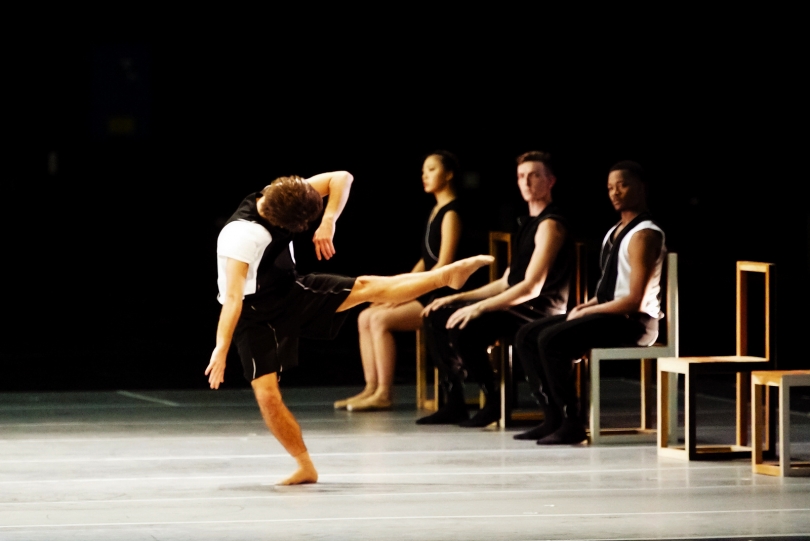It goes without saying that Johann Sebastian Bach is a towering figure in the world of western music. His works have been performed, quoted, rearranged and appropriated throughout the history of classical music. On the other hand, his influence also stretches across all kinds of media and disciplines, from high art to popular culture. There is a certain quality in Bach’s meticulously-structured compositions that make them both timeless and supreme. Wherever it is used, Bach’s music looms over the material as some foreground aural architecture rather than background accompaniment. French choreographer Benjamin Millepied and his company L.A. Dance Project certainly acknowledge Bach’s distinctive aura. In their recent work Bach Studies, they have put Bach to the forefront, and, as if performing an autopsy on the impeccable structures of his music, they attempt to translate his audible score into visible movement. The result is a 75-minute multi-sectional work that is a feast for the eyes, but also one that ultimately loses its power in the process of translation.
Bach Studies is a compilation of set-pieces around a carefully-curated Bach playlist that demonstrates the prolific composer’s diverse compositions. Strategically, it caters to audiences of various musical tastes by upholding the principle “to each their own Bach”. The selection ranges from choral to instrumental, from the sacred choral work of St. Matthew’s Passion, to the solo violin work of Partita No. 2 in D Minor, to the cascading organ work of Passacaglia in C Minor. On the other hand, Millepied does not limit himself to only using Bach’s music. Two excerpts by contemporary composer David Lang are used halfway into the performance: the “Joy”, “Glory”, “Sorrow” movements from his Mystery Sonatas and “Our Common Fate” segment from The National Anthem offer a contemporary take on the spiritual ideas that Bach constantly infused into his compositions.
Undoubtedly, the translation of these works of music into movement proves to be a feast for the eyes, creating a whole spectrum of spectacles that display not only the versatility of Millepied’s direction but also the technical brilliance of L.A. Dance Project. Known for his choreographic contributions in Darren Aronofsky’s commercially successful Black Swan, where he reworked segments from Tchaikovsky’s classical ballet Swan Lake for the big screen, Millepied certainly has a knack for managing audiences’ expectations of what kind of dance would go well with what kind of music. In Bach Studies, the choreography seems to be in unison with the music, in terms of both the dancers’ movement and the staging.
The opening segment is set to St. Matthew’s Passion, which in turn was based on the Gospel text depicting Jesus’ suffering. The corresponding choreography is heavily imbued with psychological gravity, as mirrored by the dancers’ vertical movement of falling and rising. We also see dancers gathering inside a circle delineated by chairs, as if submitting themselves to an absolute order.
Later on, the ensemble is replaced by solos and duets. Just as the dynamic partita implies polyphony within a single instrument, we can now see the multiple traits of individual dancers, as they enjoy their new-found subjectivity and begin to interact freely with the space. The motif of falling has given way to flowing, as the undulating melodies trigger some lighter and airier lateral movement across the stage.
As David Lang’s music intervenes, it serves as a detour from Bach’s density and formalism into a sparser and more atmospheric soundscape. As a choreographic response, Millepied has chosen to open up temporal and mental space for the dancers. Here, more subtle contortions and introspective floorwork can be seen.
Bach Studies culminates in a set piece by a 12-dancer ensemble, as light beams converge on them from all angles, emanating an air of predestination. The ensemble’s rapid circular motion echoes the ostinato of the Passacaglia, while generating a turbulence that parallels man’s confrontation with destiny. Meanwhile, the whirling continuity is occasionally obstructed by moments when dancers freeze in dynamic poses that, with their long flying costumes resembling medieval surcoats, seem to recall the dramatic scenes typical of Baroque paintings.
In all the instances above, it is not hard to understand Millepied’s choreographic approach - a linear mode of translation from music into movement. One can easily draw an analogy between the two, between the spatial and the aural. To borrow from linguistics, he is employing the device of simile. It is more a simile than a metaphor, because to lay bare these associations is exactly the reason why Bach Studies comes into being. A certain element of Bach’s music is “like” a certain style of body movement, or a certain idea that is written into the musical score will be manifested on stage “as if it were a stage design instruction”.
So what is the problem of this translation? While it is not uncommon for choreographers to use a piece of music as the starting point of their creation, few would use and treat the translation as the end goal. Given the fact that Bach’s music has been theorised and studied again and again since it was conceived, we are actually not entirely unfamiliar with his musical language to begin with. So do we still need a performance that is a mere translation per se? Or would we rather need some new insights into Bach’s music?
This leads us to the second problem: Bach Studies is segmented. With the piece being divided into several set pieces that are not linked by an overarching narrative, the piece fails to produce meaning other than some fragmented affective response from the audience. While we need to acknowledge that music and dance are expressive in nature and call for affective response rather than cognitive response, to elevate a spectacle into meaningful art does requires some sort of carefully-orchestrated consistency. For example, the mixture of pas-de-deux and same-sex pairings seems to point to a sort of gender neutrality and fluidity that is eventually unexplored, or even defeated in the very last scene, when male dancers are being torn apart from female dancers forming two distinctive rows.
Finally, it seems that Millepied has failed to exploit the uniquely malleable architecture of Bach’s music. Although Bach’s music has a dominant formal construction, it still exudes a heavy emotional quality. Why is that so? It may be because there is so much humanity and inherent tension in Bach’s music. First, the techniques of counterpoint and polyphony mirrors the clash of individual voices; one is reminded of how we all want to be independent while also yearning for interpersonal connections. Then, the constant modulations amidst a bigger musical motif mirror an individual’s constant straddling between conformity and freedom, and ultimately hinting at one’s existential search for free will against destiny. It is exactly due to its inherent tension and emotional ambiguity that Bach’s music is not really making a statement about anything. Unlike later pieces which have harmonies more clearly defined by chords in the left hand, Bach’s music creates a blank canvas for choreographers to project their movement ideas on, however different their ideas may be.
As proven in numerous researches, sometimes it is exactly via the displacement of the visual and the aural that the most powerful response from the audience is evoked. Actually, this happens in the beginning of Bach Studies right after the curtain opens. We are confronted with a stage which has entirely opened up before us, one that is vast, empty and naked. It has been stripped bare to reveal its architectural backbone, to the point that one can see the lighting fixtures and even the glowing “Exit” sign at the furthest end of the stage. The solemn and dense St. Matthew’s Passion blasts through the emptiness, filling a void that points to the makeshift, rehearsal-like quality of the space. This kind of dichotomy between the visual and the aural creates a kind of audience reaction that cannot be defined or anchored, a response that is not to be seen again as the piece progresses. Millepied’s wish to draw parallels with the music in his choreography proves to be limiting. The process of translation becomes arbitrary, narrowing down rather than opening up the interpretative possibilities of the original text.
All in all, to evaluate the importance of Bach Studies in the framework of contemporary dance, one needs to ask the question: does Millepied want to revolutionise our perceptions towards Bach and offer new insights on his music? Or does he want to convey his unique visions with the help of Bach’s music? The former demands a two-way model of exchange between the music and the movement, while the latter requires a stronger and more coherent idea or narrative on the choreographer’s part that rivals Bach’s aural architecture. Bach Studies would have been a significant performance piece if Millepied had pursued either route. Unfortunately, now he seems to be straddling between the two possibilities of greatness. The result is some elegant spectacles that are easily forgettable and lacking in depth and substance.
法國五月藝術節《巴哈研究》
評論場次:2019年5月4日,晚上8時15分
地點:香港文化中心大劇院
照片為網上圖片
作者簡介:紀錄片及錄像製作人,熱愛電影、表演和藝術,近年開始寫作藝評。





